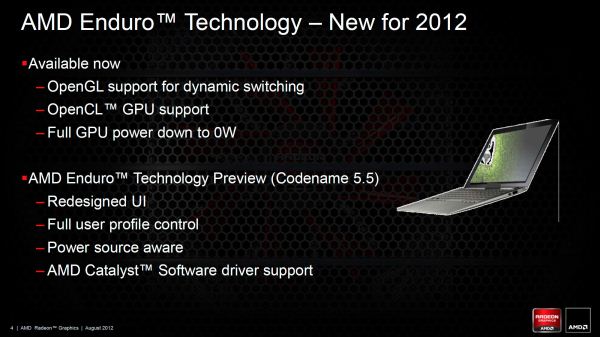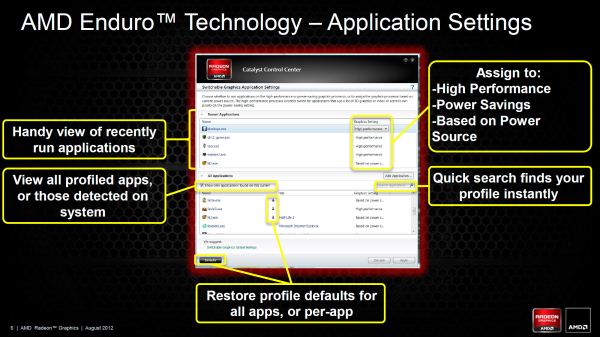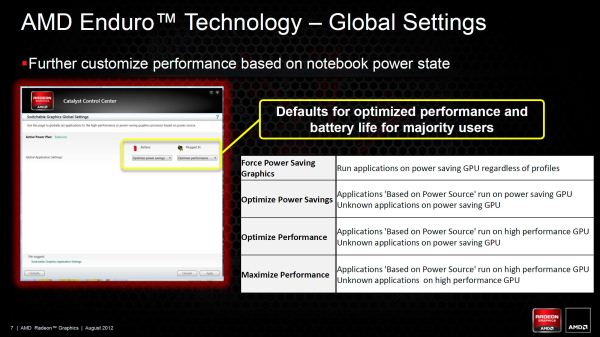AMD’s Enduro Switchable Graphics Levels Up
by Jarred Walton on September 6, 2012 3:00 AM ESTNew for Mid-2012: “Enduro 5.5” Enhancements
When AMD created the Enduro brand, they were really almost where we wanted them. They had dynamic switching with support for most of the latest games and applications, and when it worked properly it would be difficult to tell if you were using an NVIDIA or an AMD dGPU. The problem was when things didn’t work and you had to go into the drivers, and there were several problems. OpenGL support was totally out, many of the latest games were also missing default profiles (and sometimes wouldn’t let you properly specify the correct GPU), the UI was obtrusive and sometimes hard to use (particularly for power users), and the drivers were dictated by the laptop manufacturers and were usually months old at launch and never updated.
While the UI seems like a minor thing to fix—I would have thought one or two months to improve the UI would have been sufficient—at least prior to the forthcoming update it remained largely unchanged. The lack of AMD-provided driver updates was really the major issue, because everything else could potentially be fixed with new drivers and you would never know. The other areas like OpenGL/OpenCL and support for various games/applications should improve over time as well, provided you can get drivers. That brings us to the upcoming Enduro release, scheduled to come out sometime this month or next. Officially it’s still just Enduro, but to help differentiate between the previous Enduro release and the upcoming release we’ll sometimes refer to the new version as “Enduro 5.5”.
The biggest news with the latest iteration of Enduro is that AMD is planning to make universal reference drivers available for all the Enduro laptops. It’s not clear precisely what that means, but potentially any laptop with Dynamic Switchable Graphics or later (e.g. PX4.0 and later) would be supported by AMD’s “reference” drivers. That’s huge, and if AMD can deliver it will assuage most of our concerns with their hardware/software. Hopefully none of the OEMs get bent out of shape or refuse to allow support, which is a problem we've seen in the past. We should see the first public release in the next month or two, and then another release somewhere in the November/December timeframe.
Besides the availability of driver updates, the UI also receives a much needed overhaul, providing both regular and power users all the options they’re likely to need as far as control of graphics switching is concerned. Open up the switchable graphics options and the top section remains largely the same, but the bottom now allows you to see all application profiles (or just the profiles for detected applications). There’s also a quick search option that works both on executable name and application/game name (e.g. HL2.exe or Half-Life 2 will both find the profile for Half-Life 2). From either list (recently used apps up top, or all apps at the bottom), you can set the GPU profile.
Where previously there were two settings (three if you count “Not Assigned”), there are now three options. As before, “Power saving” sets an application to run on the integrated graphics while “High performance” sets an application to run on the discrete GPU. The new third option is “Based on power source”, which does precisely what you’d expect: plug the laptop in and the apps with this setting will run on the discrete GPU; switch to battery power and they’ll run on the integrated graphics. For many users, everything could default to “Based on power source” and they would be happy, but certainly there will be times where you’re running on battery power but still want to use the dGPU and the drivers give you that option. Should things get squirrelly, you can also reset applications individually or globally to their default settings. It’s worth noting that the power state aware setting is something that NVIDIA currently does not implement, requiring manual intervention if you wish to override your normal settings—though how often people are using apps that require the dGPU while on battery power is something we could debate.
Besides the individual application profiles, AMD is also adding a new area to their drivers: Switchable Graphics Global Settings. This is something you could sort of get before with some laptops, but previously it involved changing from Dynamic Switchable Graphics to manual switching (i.e. switching based on power source) and then forcing the laptop into High Performance or Power Saving mode if you wanted to be low power while plugged in or high power while unplugged. That was clunky and at least in the case of the Sony VAIO C we tested it caused flickering similar to the old switchable graphics, with the dGPU drivers getting unloaded and iGPU drivers getting loaded (or vice versa), with some work behind the scenes copying context from one GPU to the other. It worked but it wasn’t elegant; perhaps more importantly, Microsoft doesn’t want anyone doing this with Windows 8 and thus new laptops won’t be able to get a Windows 8 sticker if they use this method of switching (which basically means no new laptops will do this). To make up for the loss of this functionality (which some people still prefer), AMD has added a new global settings section.
Unlike the individual application profiles, the global settings gives you four options each for Battery and Plugged In. The top two options are similar in most cases and will generally run most applications on the iGPU, and the same goes for the bottom two modes where you’ll run most apps on the dGPU. The difference is that “Force Power Saving GPU” will run all applications (regardless of what the custom profile says) on the iGPU, essentially disabling the dGPU completely. “Optimize Power Savings” in contrast will run all unknown or “Based on power source” applications on the iGPU while respecting the application profiles where they exist. “Optimize Performance” is sort of the reverse of that, running all “Based on power source” applications on the dGPU while leaving unknown applications on the iGPU. Finally, the “Maximize Performance” option runs all unknown and “Based on power source” applications on the dGPU—but applications specifically set to use the iGPU will continue to do so.
The reason for that last discrepancy (e.g. why you can’t simply run everything on the dGPU and forget about the iGPU) is that certain tools have to run on the iGPU. Intel’s drivers are one example—loading those up on the dGPU would cause problems. Intel’s WiDi is the only other I could find on my particular Clevo notebook. We were told that some of the laptop utilities like an overlay showing percentage of brightness, volume, etc. may also need to run on the iGPU. Besides the few applications that have to run on the iGPU, any applications that are set to Power Saving will continue to use the iGPU—and this makes sense as there are a lot of applications that can be set to run on iGPU/dGPU that have no need of higher performance GPU options (several anti-virus utilities come to mind, where they're starting to create a 3D context for their UI). The net result is that other than a few specific applications where the profile will exist and be locked to the iGPU, with no option to change to dGPU, everything else that uses higher function graphics can be customized to run on a specific GPU, but if you set something to iGPU presumably you want it to always run there—otherwise you would use the “Based on power source” setting.
A full set of screenshots from all the driver screens is available in the gallery below if you’re interested.
One final topic worth discussing is Windows 8. Certainly there are owners of existing laptops with switchable graphics that are wondering if they can upgrade to Windows 8 and what will happen. We’ll have to see how this actually plays out, but it sounds like the earlier versions of PowerXpress (3.0 and earlier) will probably get support with one driver bundled with Windows 8, and that may be it—but there’s always the possibility for the laptop OEMs to release their own updates, or for AMD to roll out additional drivers for older laptops. The potential for PowerXpress 4.0 and later laptops to get regular driver updates (for Windows Vista/7/8) is there, but until we actually start seeing public driver releases AMD hasn’t fully committed to supporting all of those laptops.



















200 Comments
View All Comments
king-dubs - Thursday, September 6, 2012 - link
It is already possible to enable Enduro 5.5 UI, as I posted here (step-by-step directions):http://www.rage3d.com/board/showthread.php?p=13370...
arcticjoe - Thursday, September 6, 2012 - link
yeah, i've tried that - it changed a few things but Crysis 2 seems to be worse than before and BF3 maybe a little better than before.hulawafu77 - Thursday, September 6, 2012 - link
I highly doubt this is a fix, and morel likely just a UI face cleanup, and AMD just stalling since they still can't fix it. But if you want to try it, here it is.http://www.rage3d.com/board/showpost.php?p=1337031...
Montage - Thursday, September 6, 2012 - link
That is not the same as Enduro 5.5 and it doesn't work. Wait for the official or beta drivers. Hulawafu77, though pessimists don't get disappointed that easily they also can never be truly happy...DarkStryke - Thursday, September 6, 2012 - link
I really feel for the suckers (as AMD is basically calling them) that bought into the 7970M enduro. Having a product out a solid 6 months, with a fix still realistically nowhere, talk about a company that doesn't deserve to see another dime from customers. Then you add on top of it the removal of support threads on third party forums because they shed light on a product which is complete garbage, and well, you can't make up better motivation for people to move to nVidia (whom is far from a saint themselves).I heard the same bull for months on the desktop, 'we're working on crossfire fixes soon', and well, that's still never worked as well as SLI.
JarredWalton - Thursday, September 6, 2012 - link
Has it really been out and in customer hands for six months? Seriously? Because the first unit we could get for review just got here about a six weeks ago. I think the first shipments would have been around ten weeks ago. Six months since announcement is very different from six months since a customer actually had product in hand. The very first PRE-RELEASE hardware with IVB processors that we tested was only done in April, with the official launch on the 23rd.So best case, people have had Enduro with IVB and 7970M for 4.5 months, and the first reviews I can find of anything with 7970M are the M17x R4 posted in late May. That was likely first shipment hardware as well (before customers started getting units), but even if it's not that would mean we're down to 3.5 months. Unless I'm missing something, like maybe someone was doing SNB systems with 7970M? I'm curious: who can find the oldest official review of a notebook with 7970M?
hulawafu77 - Thursday, September 6, 2012 - link
It's been out for months. I know I've had mine for over 3 months now. And I got it after the debacle that took AMD more than a month I think to fix where the fail rate on the 7970M was 20%. So it's been out for about 5 months I'd guess. Pretty sure people had em in April.hulawafu77 - Thursday, September 6, 2012 - link
Yeah It's been about 3-4 months, not 6 months. But the GCN core has been out longer than that I thought. This issue is not just about Clevo/7970M, this is about Enduro and 7xxx GCN, which is affecting Lenovo, HP and other OEMs also.Either way, AMD should have had drivers that work on day 1 release. Didn't have to be most optimized for performance, but c'mon, when it's slower in games than a GPU that is supposedly 2x slower? That's disgraceful.
hulawafu77 - Thursday, September 6, 2012 - link
Man I wish there was an edit button. But I believe AMD should have been honest, they must have known Enduro was broken for months before the 7970M launch. They should have told Clevo and their vendors, it's broken. Please do not use a muxless design in the meantime just in case, give us the option to disable it in the BIOS like Alienware did on the M18x or a switch on the M17x. Clevo only began to use muxless this round, I don't think it's coincidence with 7970M which is supposed to be supporting Enduro. They probably would have done it sooner as Optimus was already functioning with muxless. Last years models don't support switchable graphics at all and unaffected. They could have done that with current models if AMD was honest with Clevo.Maybe AMD did tell Clevo and Clevo decided to screw it, we'll implement a technology that doesn't work right now. For some reason I doubt that.
JarredWalton - Friday, September 7, 2012 - link
Broken is all relative. It works, but it doesn't work as fast as people would like -- meaning, a high-end GPU like the 7970M ends up underperforming. As far as being broken in the sense of driver updates, AMD hasn't ever shipped a mobile GPU with switchable graphics that would qualify as "fixed" -- only NVIDIA's Optimus has managed that. Enduro 5.5 marks the start of the next stage of AMD's switchable graphics efforts in that sense.Mind you, Sony, Lenovo, HP, and others have therefore been shipping "broken" solutions for several years. Though I suppose if you don't want driver updates, they've have only been seriously underperforming with GCN.